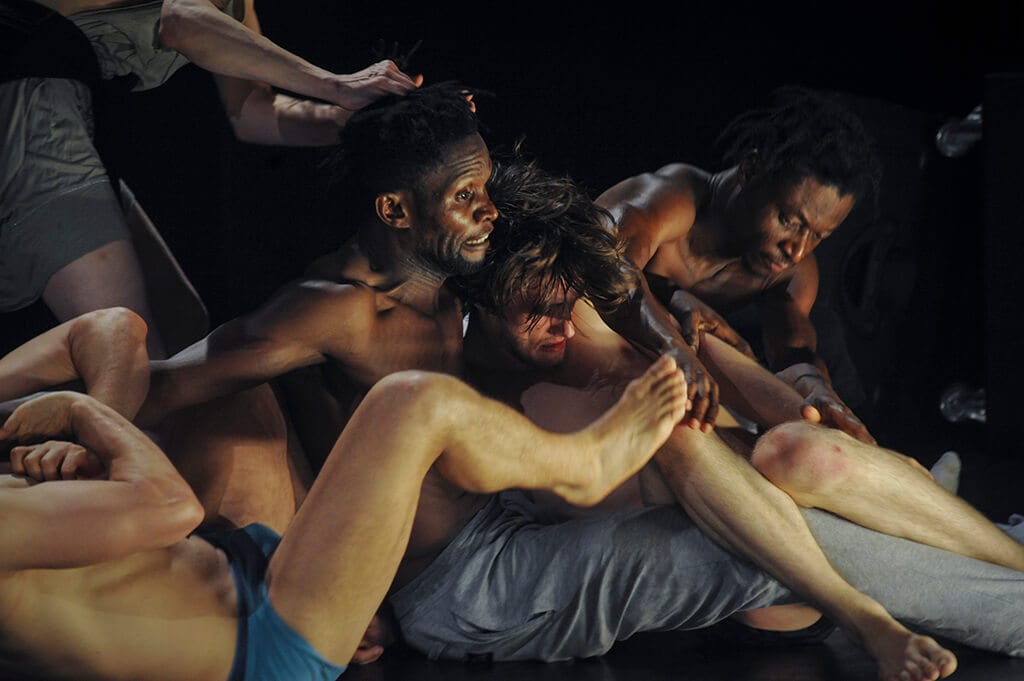Alain Platel is amongst the most political of choreographers. It is rather wonderful that he insists that being political is not his intention. Nevertheless, his work is political, though never mawkish. And no matter how grim things look on the surface, there is often a layer of humour not far below, sometimes subtle, as in the fleeting expression on a dancer’s face, sometimes endearingly clownish, as when a dancer in rags sends up a traditional little ballet sequence – and performs it so well.
Nicht Schlafen has been variously translated by reviewers in the course of the Belgian company’s nine months’ intensive touring. Usually it is something like, “No Sleep” or “Not Sleep” or “Insomnia”. My preferred translation is the injunction: Don’t sleep! For which one may hear, wake up!
Platel’s production gives us a tour through the horrors of “normal” human conduct at a time that we may take to be any time, say now, for instance. Historically, Belgium is said to have suffered more than any other European country in both World Wars. Perhaps we begin with the First World War: artist Berlinde De Bruyckere’s pile of giant bloated dead horses at the back of the stage suggests this. (Eight million horses died in the Great War.) We are also in the midst of the Second World War . . . some satirical heils march across the stage, and throughout, the choreography frequently quotes from searing concentration camp images we have all seen. We are also in a time that is the present, when destitute, frantic, lonely people who all speak different languages are herded together, wearing their jumble sale handouts.
Nor are we always in the West. The dance’s narrative line pushes an undertow: the atrocity of King Leopold’s Congo holocaust, and the nightmare that Belgium continued to inflict in the Congo well into the 1960s, or even the present, not least in arranging the murder of Patrice Lumumba, the Congo’s first – and last – elected leader.
The two Congolese stars of the show, Russell Tshiebua and Boule Mpanya, introduce an element which the audience cannot escape, and nor should we try to. Apart from their being part of the company of nine astonishing dancers, the two men are integral to the power of the whole performance. Intermittently, we re-encounter one of Platel’s familiar choreographical motifs of a dancer’s extreme body tremor or shaking limb. When the Congolese performers come forward with broad smiles, arms outstretched, shaking their hands from the wrist, the reference to King Leopold is not lost. There is piercing wit that is a retaliatory bullet in the heart of the audience.
In our own world of wars, including the Belgian world, Platel’s Don’t sleep! demonstrates that there is no way of separating the perpetrators from the victims. At any moment, a passing gesture may transform a victim into an aggressor and vice versa. Beautiful bodies make ugly shapes, fight tirelessly, strip each other – of all humanity – and cast themselves about as if, though they each have their distinct individuality, they cannot think. There is an overwhelming absence of mind. Each body engages with itself or the next one, whether alive or dead, man or beast, always in the service of the other’s destruction or of bodily satisfaction. Very occasionally there are signs of compassion, help, sharing, but when, towards the end, one of the bodies seems to be dead and broken after having been attacked, it is not clear whether the others are going to mourn it or eat it.
With all this pain, preening, aggression and copulation, what of the sound? Aside from the stirring Congolese polyphonies, there are clues in the soaring romantic and baroque music sampled and collaged by Steven Prengels. There are sung fragments – the line “hör auf zu beben, bereite dich zu leben” (“Cease trembling, prepare to live”) from Mahler’s “Resurrection” Symphony No. 2; and from Mahler’s 3rd symphony, 4th movement, excerpts from the Mitternachtslied. Mahler took it from Nietzsche’s Zarathustra – in which Nietzsche proposes, we should note, that out of tragedy something positive arises, and that the conventional virtuous life is one lived asleep while to be free and independent is to be awake. There are also excerpts from Bach’s Den Tod Niemand Zwingen Kunnt, Luther’s hymn about Christ dying for our salvation. (Es war ein wunderlicher Krieg, / da Tod und Leben rungen; / das Leben, das behielt den Sieg, / es hat den Tod verschlungen. It was a strange war that Death and Life concluded: Life remained victorious, devoured Death.)
The European pieces of music all express a deep belief in salvation after death or distress, a belief that out of tragedy something positive emerges, or that ultimately good conquers evil, life vanquishes death. Together Platel and c de la b‘s performance demonstrate a contradiction of this notion. The beautiful music and the beautiful optimism is not a hair’s breadth away from the perpetration of, or submission to, ugly, self-serving, mindless violence and suffering. Since we know our history and our present, we know that the beauty and the violence come from the identical source. We are left with the thought that our insistent optimism, our wishful belief that it will all be alright in the end, is an illusion. Indeed, it may be the problem.

